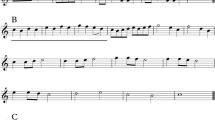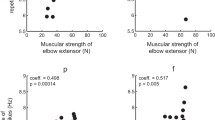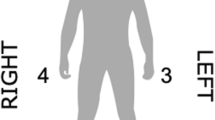Abstract
Accuracy of shifting movements between two notes was examined in nine cellists (intermediate-professional skill levels). Three pairs of notes separated by different distances were tested under the same movement rate. Finger position on the string was measured by a circuit. Angular velocities of the left upper arm and forearm were measured by two angular velocity sensors; thus elbow angular velocity during shifts was estimated. Results showed that with increased elbow velocity and shifting distance endpoint variability stayed constant. The force of gravity assisted elbow extension during shifts toward higher pitched notes compared to flexion towards lower pitched notes, but faster movement velocity did not result in increased landing variability. Performance for note E on the A string was found to be less variable than other notes, suggesting that physical cue from the cello body geometry was used as a landmark for finger position. Cutaneous feedback from the thumb when hitting the body–neck junction enabled faster elbow extension velocity compared to shifts towards other notes. Cellists who showed higher performance accuracy also showed higher perceptual ability and performance proficiency. These results suggest that long-term over-training of fast and accurate movements enables musicians to maintain accuracy and variability across different movement distances and velocities. Higher perceptual ability and performance proficiency are correlated with increased accuracy but not lower variability, indicating although perceptual ability and performance proficiency are important for pitch accuracy, movement variability is still constrained by the capacity of the motor system, which is highly fine-tuned and different than non-musicians.







Similar content being viewed by others
References
Adamovich SV, Berkinblit MB, Fookson O, Poizner H (1999) Pointing in 3D space to remembered targets. II. Effects of movement speed toward kinesthetically defined targets. Exp Brain Res 125(2):200–210
Adams JA (1971) A closed-loop theory of motor learning. J Mot Behav 3:111–149
Collewijn H, Erkelens CJ, Steinman RM (1988) Binocular co-ordination of human vertical saccadic eye movements. J Physiol (Lond) 404:183–197
Crossman ERFW, Goodeve PJ (1983) Feedback control of hand-movement and Fitts’ law. Q J Exp Psychol 35A:251–278
Fitts PM (1954) The information capacity of the human motor system in controlling the amplitude of movement. J Exp Psycol 47:381–391
Flanagan JR, Lolley S (2001) The inertial anisotropy of the arm is accurately predicted during movement planning. J Neurosci 21(4):1361–1369
Fyk J (1995) Melodic intonation, psychoacoustics, and the violin. Organon, Zielona Gora
Imanaka K (1993) Information-processing mediating the location–distance interference in motor short-term memory. Ann Physiol Anthropol 12(5):269–283
Kay BA, Turvey MT, Meijer OG (2003) An early oscillator model: studies on the biodynamics of the piano strike (Bernstein & Popova, 1930). Motor Control 7:1–45
Keele SW (1986) Motor control. In: Kaufman L, Thomas J, Boff K (eds) Handbook of perception and performance. Wiley, New York
Keele SW, Posner MI (1968) Processing visual feedback in rapid movement. J Exp Psychol 77:155–158
Kelso JAS (1977) Motor control mechanisms underlying human movement reproduction. J Exp Psychol 3:529–543
Kelso JAS, Holt KJ (1980) Exploring a vibratory systems analysis of human movement production. J Neurophysiol 43:1183–1196
Loftus A, Murphy S, McKenna I, Mon-Williams M (2005) Reduced fields of view are neither necessary nor sufficient for distance underestimation but reduce precision and may cause calibration problems. Exp Brain Res 158(3):328–335
Marteniuk RG, Mackenzie CL, Jeannerod M (1987) Constraints on human arm movements trajectories. Can J Psychol 41:365–368
Messier J, Kalaska JF (1999) Comparison of variability of initial kinematics and endpoints of reaching movements. Exp Brain Res 125(2):139–152
Meyer DE, Abrams RA, Kornblum S, Wright CE, Smith JEK (1988) Optimality in human motor performance: ideal control of rapid aimed movements. Psychol Rev 95:340–370
Meyer DE, Smith K, Kornblum S, Abrams RA, Wright CE (1990) Speed–accuracy tradeoffs in aimed movements: toward a theory of rapid voluntary action. In: Jeannerod M (ed) Attention and performance XIII: motor representation and control. Hillsdale, New Jersey, pp 173–227
Morrison S (2000) Effect of Melodic context, tuning behaviors, and experience on the intonation accuracy of wind players. J Res Music Educ 48:39–51
Palmer C, Meyer R (2000) Conceptual and motor learning in music performance. Psychol Sci 11:63–68
Papaxanthis C, Pozzo T, Stapley P (1998) Effects of movement direction upon kinematic characteristics of vertical arm pointing movements in man. Neurosci Lett 253:103–106
Pepper RL, Herman LM (1970) Decay and interference effects in the short-term retention of a discrete motor act. J Exp Psychol 83(2):1–18
Plamondon R, Alimi AM (1997) Speed/accuracy trade-offs in target-directed movements. Behav Brain Sci 20:279–349
Polit A, Bizzi E (1979) Characteristics of motor programs underlying arm movements in monkeys. J Neurophysiol 42:183–194
Rosenbaum D (1991) Human motor control. Academic, New York
Schlykowa L, Hoffmann KP, Bremmer F, Thiele A, Ehrenstein WH (1996) Monkey saccadic latency and pursuit velocity show a preference for upward directions of target motion. NeuroReport 7:409–412
Schmidt RA, Zelaznik HN, Hawkins B, Frank JS, Quinn JT Jr (1979) Motor output variability: a theory for the accuracy of rapid motor acts. Psychol Rev 86:415–452
Stelmach GE et al (1975) Preselection in short-term motor memory. J Exp Psychol 1:745–755
Stelmach GE et al (1976) Preselection and response biasing in short-term motor memory. Mem Cogn 4:62–66
Smyrnis N, Evdokimidis I, Constantinidis TS, Kastrinakis G (2000) Speed–accuracy trade-off in the performance of pointing movements in different directions in two-dimensional space. Exp Brain Res 134:21–31
Winold H, Thelen E, Feng J (2002) On the rebound. The Strad 514–521
Woodworth RS (1899) The accuracy of voluntary movement. Psychol Rev 3(13):1–114
Acknowledgement
The authors wish to thank Dr. Paul van Donkelaar for his comments on the earlier version of this manuscript. This study was funded by a grant from the National Academy of Recoding Arts and Sciences to M. Woollacott, PI.
Author information
Authors and Affiliations
Corresponding author
Rights and permissions
About this article
Cite this article
Chen, J., Woollacott, M. & Pologe, S. Accuracy and underlying mechanisms of shifting movements in cellists. Exp Brain Res 174, 467–476 (2006). https://doi.org/10.1007/s00221-006-0483-x
Received:
Accepted:
Published:
Issue Date:
DOI: https://doi.org/10.1007/s00221-006-0483-x




